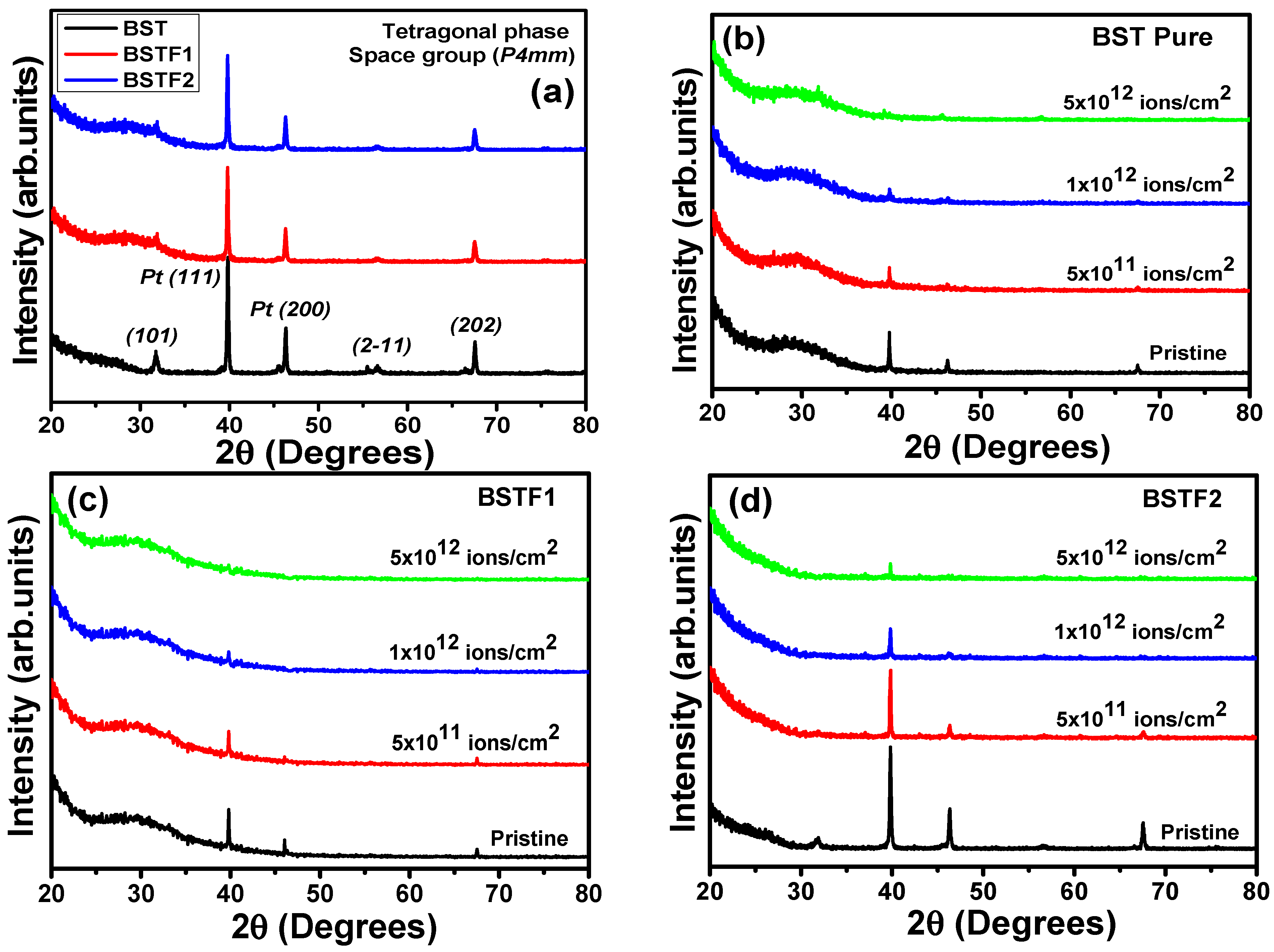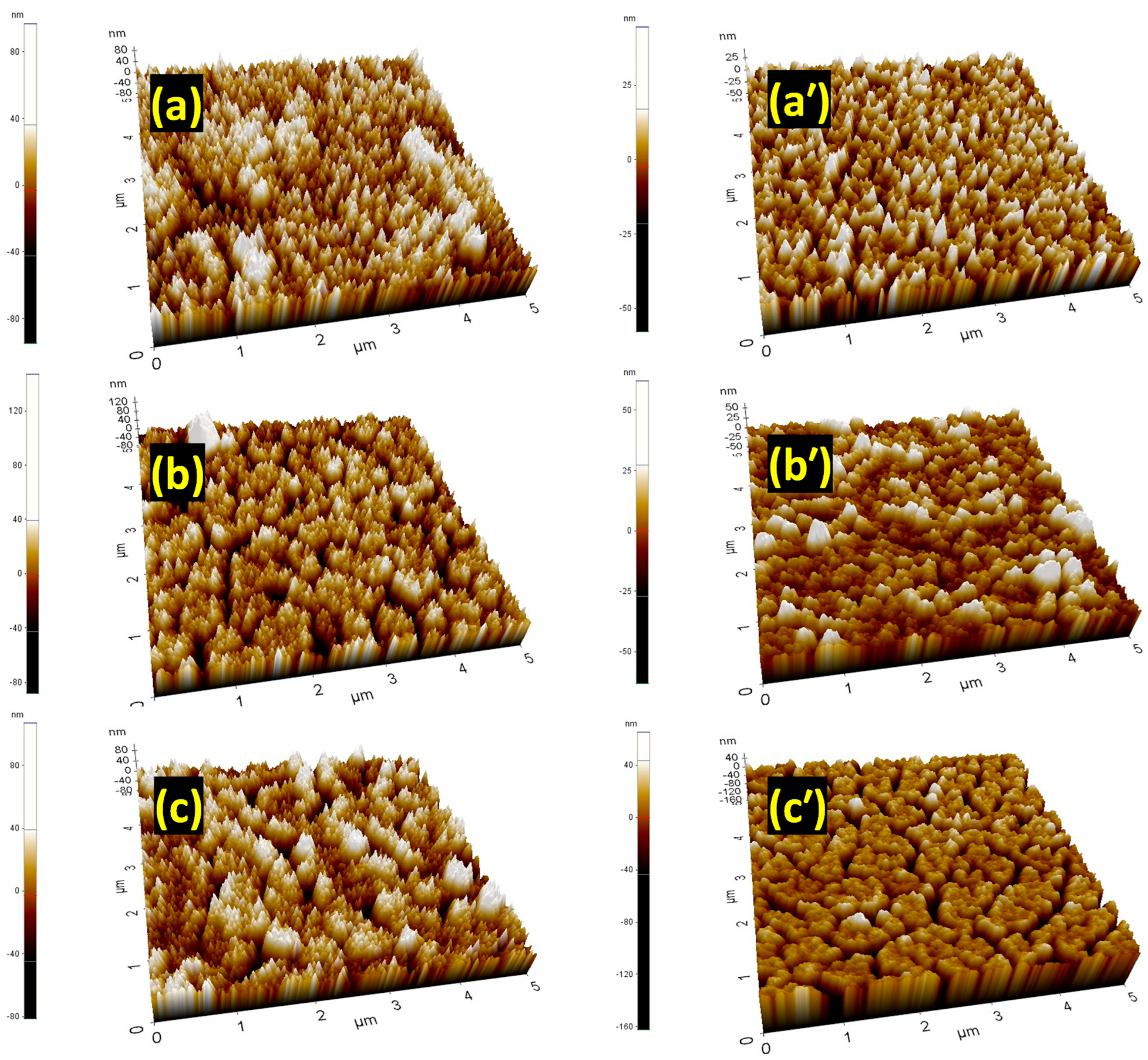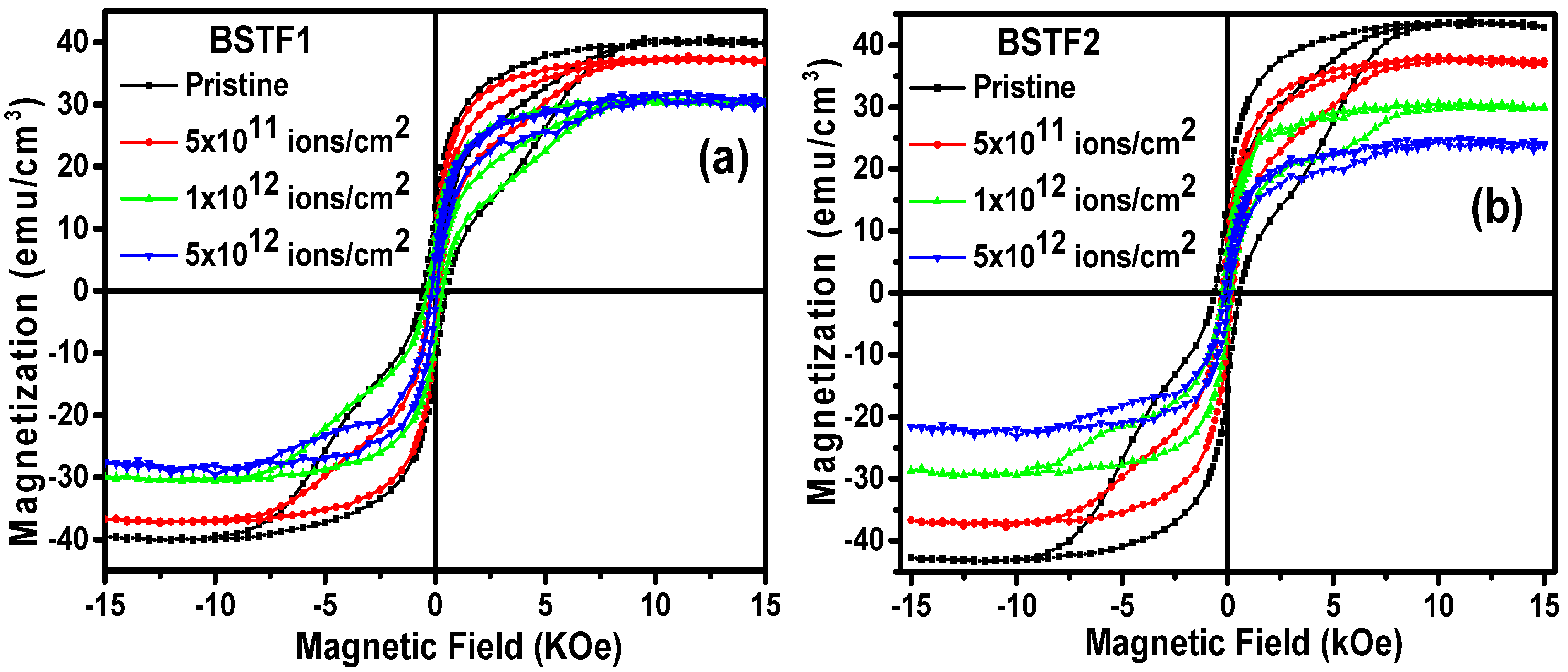Electronic Excitation-Induced Modification in Electronic Structure and Magnetism for Pulsed Laser Deposited Barium Strontium Titanate Thin Films with Changing Fe Impurity
Abstract
1. Introduction
2. Experimental Methods
3. Results and Discussions
3.1. Structural Analysis
3.2. Microscopic Modification Observed from AFM Micrographs
3.3. Influence of Irradiation on Surface Oxidation States
3.4. Irradiation-Induced Changes in Magnetism
4. Conclusions
Author Contributions
Funding
Institutional Review Board Statement
Informed Consent Statement
Data Availability Statement
Acknowledgments
Conflicts of Interest
References
- Maier, R.; Cohn, J.L.; Neumeier, J.J.; Bendersky, L.A. Ferroelectricity and ferrimagnetism in iron-doped BaTiO3. Appl. Phys. Lett. 2001, 78, 2536–2538. [Google Scholar] [CrossRef]
- Ueda, K.; Tabata, H.; Kawai, T. Coexistence of ferroelectricity and ferromagnetism in BiFeO3–BaTiO3 thin films at room temperature. Appl. Phys. Lett. 1999, 75, 555–557. [Google Scholar] [CrossRef]
- Singh, A.; Gupta, A.; Chatterjee, R. Enhanced magnetoelectric coefficient (α) in the modified BiFeO3–PbTiO3 system with large La substitution. Appl. Phys. Lett. 2008, 93, 22902. [Google Scholar] [CrossRef]
- Kaur, A.; Singh, A.; Singh, L.; Mishra, S.K.; Babu, P.D.; Asokan, K.; Kumar, S.; Chen, C.L.; Yang, K.S.; Wei, D.H. Structural, magnetic and electronic properties of iron doped barium strontium titanate. RSC Adv. 2016, 6, 112363–112369. [Google Scholar] [CrossRef]
- Samantaray, C.B.; Dhar, A.; Bhattacharya, D.; Mukherjee, M.L.; Ray, S.K. Effect of post-deposition annealing on microstructural and optical properties of barium strontium titanate thin films deposited by rf magnetron sputtering. J. Mater. Sci. Mater. Electron. 2001, 12, 365–370. [Google Scholar] [CrossRef]
- Vanderah, T.A.; Loezos, J.M.; Roth, R.S. Magnetic dielectric oxides: Subsolidus phase relations in the bao: Fe2O3: Tio2system. J. Solid State Chem. 1996, 121, 38–50. [Google Scholar] [CrossRef]
- Guo, Z.; Pan, L.; Bi, C.; Qiu, H.; Zhao, X.; Yang, L.; Rafique, M.Y. Structural and multiferroic properties of Fe-doped Ba0. 5Sr0. 5TiO3 solids. J. Magn. Magn. Mater. 2013, 325, 24–28. [Google Scholar] [CrossRef]
- Maier, R.; Cohn, J.L. Ferroelectric and ferrimagnetic iron-doped thin-film BaTiO3: Influence of iron on physical properties. J. Appl. Phys. 2002, 92, 5429–5436. [Google Scholar] [CrossRef]
- Shukla, D.K.; Kumar, R.; Mollah, S.; Choudhary, R.J.; Thakur, P.; Sharma, S.K.; Brookes, N.B.; Knobel, M. Swift heavy ion irradiation induced magnetism in magnetically frustrated BiMn2O5 thin films. Phys. Rev. B 2010, 82, 174432. [Google Scholar] [CrossRef]
- Toulemonde, M.; Dufour, C.; Paumier, E. Transient thermal process after a high-energy heavy-ion irradiation of amorphous metals and semiconductors. Phys. Rev. B 1992, 46, 14362. [Google Scholar] [CrossRef]
- Toulemonde, M. Nanometric phase transformation of oxide materials under GeV energy heavy ion irradiation. Nucl. Instrum. Methods Phys. Res. B 1999, 156, 1–11. [Google Scholar] [CrossRef]
- Das, A.; Singh, F. Electronic excitation induced anomalous band gap enhancement in NixCd1-xO thin films. Vacuum 2017, 146, 287–296. [Google Scholar] [CrossRef]
- Sharma, M.; Gaur, A.; Quamara, J.K. Swift heavy ions irradiated PVDF/BaTiO3 film as a separator for supercapacitors. Solid State Ion. 2020, 352, 115342. [Google Scholar] [CrossRef]
- Norgren, B.S.; Somers, M.A.J.; De Wit, J.H.W. Application of tougaard background subtraction to XPS spectra of passivated Fe–17 Cr. Surf. Interface Anal. 1994, 21, 378–381. [Google Scholar] [CrossRef]
- Kaur, A.; Singh, D.; Das, A.; Asokan, K.; Chen, C.-L.; Mishra, I.B.; Ahuja, R. Spin and valence variation in cobalt doped barium strontium titanate ceramics. Phys. Chem. Chem. Phys. 2022, 24, 19865–19881. [Google Scholar] [CrossRef]
- Kang, P.-S.; Kim, K.-T.; Kim, D.-P.; Kim, C.-I.; Efremov, A.M. Dry etching characteristics of (Ba0.6, Sr0.4) TiO3 thin films in high density CF4/Ar plasma. Surf. Coat. Technol. 2003, 171, 273–279. [Google Scholar] [CrossRef]
- Craciun, V.; Singh, R.K. Characteristics of the surface layer of barium strontium titanate thin films deposited by laser ablation. Appl. Phys. Lett. 2000, 76, 1932–1934. [Google Scholar] [CrossRef]
- Gao, H.; Tian, J.; Tan, F.; Zheng, H.; Zhang, W. Tuning optical and magnetic properties of nanocrystalline BaTiO3 films by Fe doping. Appl. Phys. A 2018, 124, 835. [Google Scholar] [CrossRef]
- Coey, J.M.D.; Venkatesan, M.; Fitzgerald, C.B. Donor impurity band exchange in dilute ferromagnetic oxides. Nat. Mater. 2005, 4, 173–179. [Google Scholar] [CrossRef]
- Wei, X.K.; Su, Y.T.; Sui, Y.; Zhang, Q.H.; Yao, Y.; Jin, C.Q.; Yu, R.C. Structure, electrical and magnetic property investigations on dense Fe-doped hexagonal BaTiO3. J. Appl. Phys. 2011, 110, 114112. [Google Scholar] [CrossRef]
- Qin, S.; Liu, D.; Zuo, Z.; Sang, Y.; Zhang, X.; Zheng, F.; Liu, H.; Xu, X.-G. UV-irradiation-enhanced ferromagnetism in BaTiO3. J. Phys. Chem. Lett. 2010, 1, 238–241. [Google Scholar] [CrossRef]
- Lian, J.; Wang, L.M.; Wang, S.X.; Chen, J.; Boatner, L.A.; Ewing, R.C. Nanoscale manipulation of pyrochlore: New nanocomposite ionic conductors. Phys. Rev. Lett. 2001, 87, 145901. [Google Scholar] [CrossRef] [PubMed]
- Wang, L.; Gong, W.; Wang, S.; Ewing, R.C. Comparison of ion-beam irradiation effects in X2YO4 compounds. J. Am. Ceram. Soc. 1999, 82, 3321–3329. [Google Scholar] [CrossRef]
- Barbu, A.; Dunlop, A.; Lesueur, D.; Averback, R.S. Latent tracks do exist in metallic materials. Europhys. Lett. 1991, 15, 37. [Google Scholar] [CrossRef]
- Liu, L.; Huang, Y.; Li, Y.; Fang, L.; Dammak, H.; Fan, H.; Thi, M.P. Orthorhombic to tetragonal structural phase transition in Na0.5K0.5NbO3-based ceramics. Mater. Lett. 2012, 68, 300–302. [Google Scholar] [CrossRef]
- Szenes, G. General features of latent track formation in magnetic insulators irradiated with swift heavy ions. Phys. Rev. B 1995, 51, 8026. [Google Scholar] [CrossRef]
- Audouard, A.; Balanzat, E.; Bouffard, S.; Jousset, J.C.; Chamberod, A.; Dunlop, A.; Lesueur, D.; Fuchs, G.; Spohr, R.; Vetter, J. Evidence for amorphization of a metallic alloy by ion electronic energy loss. Phys. Rev. Lett. 1990, 65, 875. [Google Scholar] [CrossRef]
- Kaur, A.; Singh, D.; Das, A.; Singh, S.; Asokan, K.; Singh, L.; Mishra, I.B.; Ahuja, R. Correlation between reduced dielectric loss and charge migration kinetics in NdFeO3-modified Ba0.7Sr0.3TiO3 ceramics. J. Mater. Sci. Mater. Electron. 2021, 32, 24910–24929. [Google Scholar] [CrossRef]







Disclaimer/Publisher’s Note: The statements, opinions and data contained in all publications are solely those of the individual author(s) and contributor(s) and not of MDPI and/or the editor(s). MDPI and/or the editor(s) disclaim responsibility for any injury to people or property resulting from any ideas, methods, instructions or products referred to in the content. |
© 2025 by the authors. Licensee MDPI, Basel, Switzerland. This article is an open access article distributed under the terms and conditions of the Creative Commons Attribution (CC BY) license (https://creativecommons.org/licenses/by/4.0/).
Share and Cite
Das, A.; Bittencourt, C. Electronic Excitation-Induced Modification in Electronic Structure and Magnetism for Pulsed Laser Deposited Barium Strontium Titanate Thin Films with Changing Fe Impurity. Materials 2025, 18, 2534. https://doi.org/10.3390/ma18112534
Das A, Bittencourt C. Electronic Excitation-Induced Modification in Electronic Structure and Magnetism for Pulsed Laser Deposited Barium Strontium Titanate Thin Films with Changing Fe Impurity. Materials. 2025; 18(11):2534. https://doi.org/10.3390/ma18112534
Chicago/Turabian StyleDas, Arkaprava, and Carla Bittencourt. 2025. "Electronic Excitation-Induced Modification in Electronic Structure and Magnetism for Pulsed Laser Deposited Barium Strontium Titanate Thin Films with Changing Fe Impurity" Materials 18, no. 11: 2534. https://doi.org/10.3390/ma18112534
APA StyleDas, A., & Bittencourt, C. (2025). Electronic Excitation-Induced Modification in Electronic Structure and Magnetism for Pulsed Laser Deposited Barium Strontium Titanate Thin Films with Changing Fe Impurity. Materials, 18(11), 2534. https://doi.org/10.3390/ma18112534






